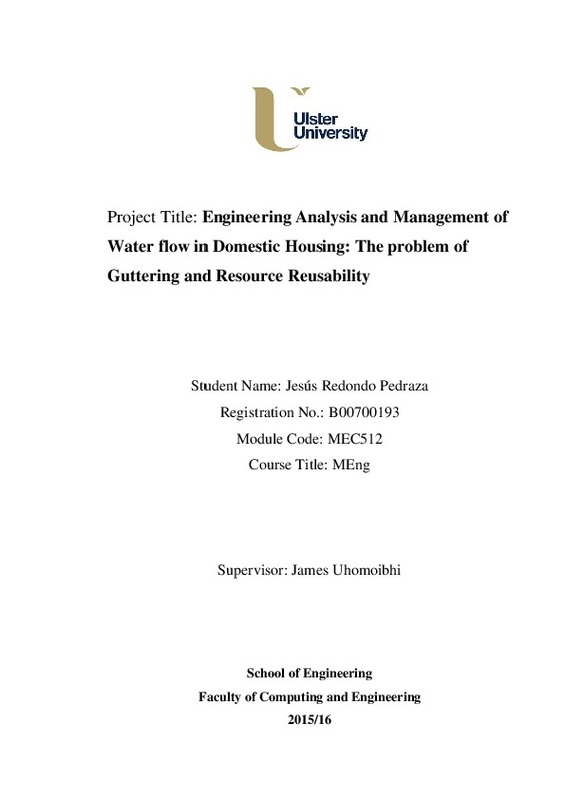|
Resumen:
|
[ES] Los patrones de drenaje han sido alterados por el incremento de la urbanización y el sellado de los suelos, provocando un incremento en el riesgo de inundaciones y reduciendo la recarga de acuíferos. Es el momento de ...[+]
[ES] Los patrones de drenaje han sido alterados por el incremento de la urbanización y el sellado de los suelos, provocando un incremento en el riesgo de inundaciones y reduciendo la recarga de acuíferos. Es el momento de mejorar la gestión del agua de lluvia desde una visión holística.
Han sido desarrollados dos casos de estudio en dos institutos públicos en una ciudad mediterránea. El objetivo es implementar varios SuDS (Sistemas de Drenaje Sostenible), haciendo simulaciones con el programa SWMM (Stormwater Management Model) para conocer como de factible podría ser. En el caso de estudio 1 ha sido implementado un techo verde y para el caso de estudio 2 se ha estudiado la cosecha y redirección de la escorrentía de dos tejados.
Los resultados han sido satisfactorios ya que el caudal pico ha sido reducido utilizando el techo verde y el estudio del riego permite mantenerlo con una máxima eficiencia y un mínimo mantenimiento asegurado. Por otro lado, ha sido posible ver como el agua puede ser almacenada y reutilizada, y cuanta cantidad de agua es redirigida a los acuíferos o ríos porque el tanque esta lleno, y de esta forma es devuelta al ciclo natural del agua.
En conclusión, los resultados muestran que el proyecto es viable con una mínima inversión, a su vez es sostenible y puede reducir y adaptarse al cambio climático. Este modelo tiene infinidad de posibilidades y puede ser adaptado a muchos casos y ver el comportamiento global del sistema.
Definitivamente, en el futuro, este modelo sera necesario.
[-]
[EN] Urban drainage patterns are altered by increasing urbanization and soil sealing, leading to increased flood risk and diminish of aquifer recharge. It is the moment to take a holistic view, and improve the stormwater ...[+]
[EN] Urban drainage patterns are altered by increasing urbanization and soil sealing, leading to increased flood risk and diminish of aquifer recharge. It is the moment to take a holistic view, and improve the stormwater management.
Two cases of study have been researched in two publics¿ institutes in a Mediterranean city. The aim is to implement several SuDS (Sustainable Drainage Systems), making simulations with the SWMM (Stormwater Management Model) software to realize about of how feasible it might be. In the Case study 1 has been implement a sustainable green roof and in the Case of study 2, the harvest and redirection of the runoff from the two rooftops.
The results have been successful, since the peak runoff has been reduced using the green roof, and the irrigation studio allows keep it with the maximum efficiency and minimum maintenance assured. On the other hand, it has been possible to see how much water can be harvested and reuse it, and how much water is redirected to the aquifer or the river because the tank is full, so is returned to the natural cycle water.
In conclusion, the outcomes show that the project is viable with a minim inversion, as well as it is sustainable and can reduce and adapts climate change. This model has infinity of possibilities and can be adapted to many cases and see the behaviour of the whole system.
Definitely, in the future, this model will be necessary.
[-]
|
|
Palabras clave:
|
Gestión
,
Agua de lluvia
,
Modelo
,
Cambio
,
Climático
,
Simulación
,
Drenaje
,
Urbano
,
Patrones
,
Alterados
,
Cosecha
,
Techo
,
Verde
,
Canalizaciones
,
Caudal
,
Pico
,
Tanque
,
Reutilización
,
Riesgo
,
Inundaciones
,
Recarga
,
Acuíferos
,
Visión
,
Holistica
,
Estormed
,
Proyecto
,
Europeo
,
Ciudades
,
Mediterráneo
,
Fuertes lluvias.
,
Stormwater
,
Management
,
Model
,
Change
,
Climate
,
Simulation
,
Drainage
,
Urban
,
Patterns
,
Altered
,
Harvest
,
Green
,
Roof
,
Guttering
,
Peak flow
,
Tank
,
Reuse
,
Flood
,
Risk
,
Aquifer recharge
,
Holistic
,
View
,
Project
,
Mediteranean
,
Cities
,
Heavy
,
Rainfall.
|







